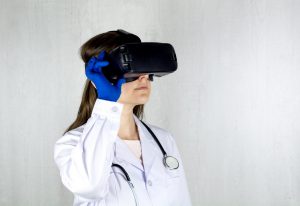Written by: Nevada Yahchouchi
Reading time: 7 minutes
Economic Advantages of Telehealth and Virtual Health Practitioners
The healthcare industry has always been a vital element in our societies, therefore, as interpreted in the previous article on ‘Telemedicine and women’, telehealth is a disruptive modality that challenges the traditional model of having a clinician or patient physically present for an appointment. The benefit is that it offers the opportunity to redesign the way services are offered to the customer. For instance, a virtual health practitioner can provide videoconference consultations while being located anywhere in the world that has internet. A virtual health practitioner also obviates the issues of attracting a specialist medical workforce to rural areas, and allows the rural health service to control the specialist services that they offer.
Telehealth could save hospitals in rural parts of the country an average of €79.000,- annually. But that economic impact would likely spread throughout the community, cutting down on travel costs for patients and boosting revenues for other healthcare providers. The estimates were published in a report by NTCA, The Rural Broadband Association, which used economic data from 24 rural hospitals in four states to calculate the potential costs savings of a telehealth program for community members and hospitals.
Although hospitals would likely see costs decline after reducing the number of full-time providers and utilizing specialists in urban areas, patients would see dramatic reductions in travel costs and lost wages. Community members would save an average of €23.000,- each year in travel costs, and recoup nearly €16.000,- in lost wages for patients traveling farther to receive specialty care.

Virtual Healthcare
The socio-economic impact of telehealth
Reviewing the socio-economic impact of telehealth we focused on nine main areas to be considered the most impactful: pediatrics, geriatrics, first nations, home care, mental health, radiology, renal dialysis, rural/remote health services, and rehabilitation. A search led to the identification of 4646 abstracts; from these, 306 sources were analysed. A central finding was that telehealth studies to date have not used these socio-economic indicators consistently. However, specific telehealth applications have been shown to offer significant socio-economic benefit, to patients and families, health-care providers, and the health-care system.
The main benefits were: increased access to health services, cost-effectiveness, enhanced educational opportunities, improved health outcomes, better quality of care, better quality of life and enhanced social support. Although the review found a number of areas of socio-economic benefit, there is the continuing problem of limited generalizability.
Another benefit for Telehealth; ‘It’s better for the environment’
One of the nation’s largest health systems has found that its telehealth platform is not only helping patients and providers, but reducing greenhouse gas emissions and also saving trees. Telehealth is often marketed for its benefits to the patient and clinician, but what about its effect on the environment?
Health services have considerable environmental impacts through the production of greenhouse gases and air pollutants. Changes to service provision are needed to mitigate these impacts. Telemedicine may be one tool to achieve this through reductions in mobility and travel as mentioned.
A review was conducted using four databases. The search was limited to original studies in English. Studies were critically appraised using a cross sectional and economic modelling tool. Results were extracted for environmental impacts of the telemedicine service. The reporting of this review is in line with PRISMA guidelines
Out of 2,916 search results, 14 met full inclusion criteria. All 14 studies found an environmental benefit of telemedicine versus ‘face-to-face’ consultations through reduced greenhouse gas emissions from travel. Three studies found there to be fewer greenhouse gas emissions through telemedicine consultations after accounting for greenhouse gas emissions from the use of telemedicine equipment
“We recognize the significant impacts virtual visits have had on our carbon footprint across the country,” Sister Mary Ellen Leciejewski, system vice president for environmental sustainability for Chicago-based CommonSpirit Health, said in a press release issued on Earth Day last month. “Our virtual visits reduced greenhouse gas emissions equivalent to planting over 250,000 trees and removing more than 3,000 cars from roadways for an entire year. With virtual visits, healthcare is more accessible and convenient, green and sustainable.”
The company charted 1.5 million virtual visits between March 16, 2020 and April 2, 2021 to more than 1,400 locations in 21 states, and found that those visits equate to 37,440,731 miles not traveled and 1,678,956 gallons of gas saved, for a monetary savings of $3.509 million. In terms of time spent in transit and in a waiting room or exam room, the company estimates that patients saved 923,276 hours by going online. Furthermore, all that time not spent on the road reduced traffic congestion (and driver stress, for that matter) and resulted in 15,092 metric tons of carbon dioxide emissions not coming out of the tailpipe, which in turn translates to roughly 18,490 acres of forest saved.

Remote Telehealth
The future of telemedicine
Telemedicine’s technology has some pain points, while telemedicine has undoubtedly come a long way, it still has significant limitations. One of the biggest limitations is provider usability. Often, telemedicine “platforms” are actually several disparate solutions cobbled together. These may include a video conferencing app, patient registration portal for demographic and insurance information, EMR, e-prescription app, and discharge system. Still, much can be transformed for the betterment of the environment, social wellbeing, and economy with a modern approach to healthcare.

Nevada Yahchouchi Content Creator: International Business
Nevada is a young professional passionate about Enterpreneurship, women empowerment and human rights. She holds a bachelor’s degree in Economics and a Master’s degree in International Economics and finance at the Lebanese University. In her organisation role she contributes to Enterpreneurship, business and youth empowerment, in particular to the achievement of the UN sustainable development goals. She joined CoSE in 2022 as a content creator to write articles about these topics in order to raise awareness and bring her generation closer to the idea of creating the life they want, make them part of active change and pushing them to embark on the journey to feel passionate about.


